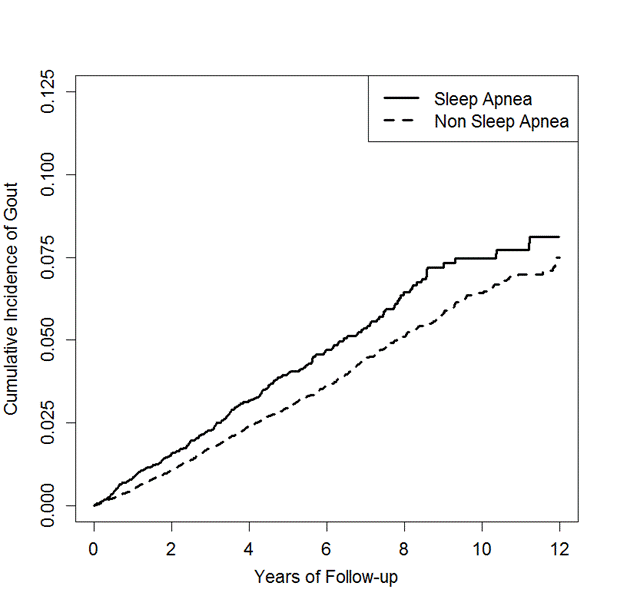Session Information
Session Type: Abstract Submissions (ACR)
Background/Purpose: Sleep apnea is common among obese individuals with comorbidities (up to ~30%), a typical profile of gout patients. Since hypoxia associated with sleep apnea can enhance nucleotide turnover (thereby generating purines, which are metabolized to uric acid), sleep apnea could predispose individuals to gout. Furthermore, previous studies have reported that patients with sleep apnea have a higher prevalence of hyperuricemia. All of these findings suggest that patients with sleep apnea may experience an increased risk of incident gout. We evaluated the risk of developing gout in individuals with incident sleep apnea in a general population context.
Methods: We conducted a matched cohort study in a UK general practice database (The Health Improvement Network, THIN) to test proposed hypothesis. We identified individuals aged 20-89 years with the first diagnosis of sleep apnea from Year 2000 to 2013. For each sleep apnea patient, up to four comparators were selected and matched on sex, age, year of birth, body mass index (BMI) (± 0.5kg/m2), and year of index date (i.e., year of sleep apnea diagnosis). We excluded subjects with sleep apnea or gout prior to study entry as well as subjects without at least one GP visit within the two years prior to study entry. We identified all cases of incident gout based on diagnosis Read code. We estimated the incidence rates of gout and used a Cox-proportional hazard model to assess the association of sleep apnea and the risk of incident gout, after further adjusting for the number of physician visits, alcohol use, BMI, age, use of aspirin, diuretics and losartan, and chronic renal disease, diabetes, hypertension and ischemic heart disease.
Results: Included in this analysis were 9865 newly diagnosed sleep apnea patients (women: 28%, mean age: 53 years, mean BMI: 33.4 kg/m2) and 43,598 comparators (women: 28%, mean age: 54 years, mean BMI: 32.2 kg/m2). Over the follow-up period, 1353 incident gout patients were diagnosed. The incidence rate of gout was higher in sleep apnea patients (7.9/1000 person-years) than in the comparators (6.1/1000 person-years) (Figure). After adjusting for all potential confounders, patients with sleep apnea had a 20% higher risk of developing gout than the comparators (hazard ratio =1.2, 95% CI: 1.0-1.4). The corresponding hazard ratios over 6-months, 1-year, and 2-years were 1.7 (95% CI: 1.1-2.8), 1.6 (95% CI: 1.2-2.1), and 1.4 (95% CI: 1.1-1.7), respectively.
Conclusion: This large general population-based study indicates that sleep apnea is associated with a high risk of incident gout. As sleep apnea is common in patients with a typical profile of gout patients and its associated hypoxia is treatable (e.g., with non-invasive ventilation Continuous Positive Airways Pressure), further clarification of the role of sleep apnea on gout attacks among gout patients could add considerably to effective management of gout.
Disclosure:
Y. Zhang,
None;
C. Peloquin,
None;
M. Dubreuil,
None;
E. Roddy,
None;
N. Lu,
None;
T. Neogi,
None;
H. K. Choi,
Takeda,
5,
AstraZeneca,
5.
« Back to 2014 ACR/ARHP Annual Meeting
ACR Meeting Abstracts - https://acrabstracts.org/abstract/sleep-apnea-and-risk-of-incident-gout-a-population-based-body-mass-index-matched-cohort-study/

